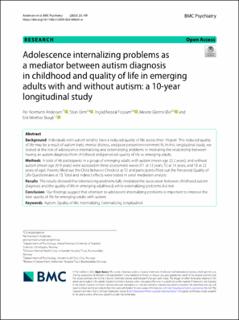| dc.contributor.author | Andersen, Per Normann | |
| dc.contributor.author | Orm, Stian | |
| dc.contributor.author | Fossum, Ingrid Nesdal | |
| dc.contributor.author | Øie, Merete Glenne | |
| dc.contributor.author | Skogli, Erik Winther | |
| dc.date.accessioned | 2023-08-24T07:12:59Z | |
| dc.date.available | 2023-08-24T07:12:59Z | |
| dc.date.created | 2023-02-27T17:51:42Z | |
| dc.date.issued | 2023 | |
| dc.identifier.citation | BMC Psychiatry. 2023, 23, 149. | en_US |
| dc.identifier.issn | 1471-244X | |
| dc.identifier.uri | https://hdl.handle.net/11250/3085527 | |
| dc.description | © The Author(s) 2023. This article is licensed under a Creative Commons Attribution 4.0 International License. | en_US |
| dc.description.abstract | Background Individuals with autism tend to have a reduced quality of life across their lifespan. This reduced quality of life may be a result of autism traits, mental distress, and poor person/environment fit. In this longitudinal study, we looked at the role of adolescence internalizing and externalizing problems in mediating the relationship between having an autism diagnosis from childhood and perceived quality of life as emerging adults.Methods A total of 66 participants in a group of emerging adults with autism (mean age 22.2 years), and without autism (mean age 20.9 years) were assessed in three assessment waves (T1 at 12 years, T2 at 14 years, and T3 at 22 years of age). Parents filled out the Child Behavior Checklist at T2 and participants filled out the Perceived Quality of Life Questionnaire at T3. Total and indirect effects were tested in serial mediation analysis.Results The results showed that internalizing problems fully mediated the association between childhood autism diagnosis and the quality of life in emerging adulthood, while externalizing problems did not.Conclusion Our findings suggest that attention to adolescent internalizing problems is important to improve the later quality of life for emerging adults with autism. | en_US |
| dc.language.iso | eng | en_US |
| dc.rights | Navngivelse 4.0 Internasjonal | * |
| dc.rights.uri | http://creativecommons.org/licenses/by/4.0/deed.no | * |
| dc.subject | autism | en_US |
| dc.subject | quality of life | en_US |
| dc.subject | internalizing | en_US |
| dc.subject | externalizing | en_US |
| dc.subject | longitudinal | en_US |
| dc.title | Adolescence internalizing problems as a mediator between autism diagnosis in childhood and quality of life in emerging adults with and without autism: a 10-year longitudinal study | en_US |
| dc.type | Peer reviewed | en_US |
| dc.type | Journal article | en_US |
| dc.description.version | publishedVersion | en_US |
| dc.subject.nsi | VDP::Samfunnsvitenskap: 200::Psykologi: 260 | en_US |
| dc.source.volume | 23 | en_US |
| dc.source.journal | BMC Psychiatry | en_US |
| dc.source.issue | 1 | en_US |
| dc.identifier.doi | 10.1186/s12888-023-04635-w | |
| dc.identifier.cristin | 2129796 | |
| dc.source.articlenumber | 149 | en_US |
| cristin.ispublished | true | |
| cristin.fulltext | original | |
| cristin.qualitycode | 2 | |

